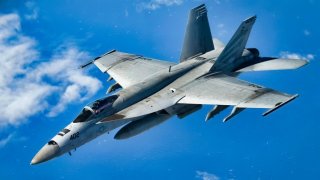F/A-18 Block III Super Hornet: Now the Unstoppable Navy Fighter
The McDonnell Douglas F/A-18 Hornet has been a cornerstone of U.S. naval aviation since 1984. Its successor, the F/A-18E/F Super Hornet, introduced in 2001, offers significant upgrades, including increased size, range, and advanced technology.
Summary and Key Points: The McDonnell Douglas F/A-18 Hornet has been a cornerstone of U.S. naval aviation since 1984. Its successor, the F/A-18E/F Super Hornet, introduced in 2001, offers significant upgrades, including increased size, range, and advanced technology.
-The latest Block III variant further enhances the platform with increased lifespan, a customizable touch screen for pilots, and reduced radar cross section. The introduction of conformal fuel tanks is anticipated, boosting fuel capacity crucial for operations in contested regions like the South China Sea.
-These upgrades ensure the Super Hornet remains a formidable asset in modern naval warfare.
How the F/A-18E/F Super Hornet Became the Navy’s Ultimate Workhorse
The McDonnell Douglas F/A-18 Hornet has been the mainstay of tactical U.S. naval aviation since its debut in 1984.
Based on the platform’s proven technology, in 2001 Boeing rolled out the F/A-18E/F Super Hornet, or Rhino, a significant upgrade on the fourth-generation strike fighter. All of the Navy’s strike fighter squadrons have transitioned to the Super Hornet, which has seen multiple successful combat deployments.
Although sharing the same designation and similar names, the Super Hornet is a meaningfully different aircraft. It is approximately 20% larger and weighs nearly 7,000 lbs more than the Legacy Hornet, with increased capability and functionality. Additional hardpoints and more powerful engines allow it to carry more ordnance and increase its range, and redesigned engine intakes make it more difficult to detect. Its powerful Mission Computers (MCs) process more data, faster.
All of these upgrades have turned the Super Hornet into an outstanding platform and the workhorse of the U.S. Navy. As happened with the Legacy, however, two decades after its inception, the Navy has recognized the need for further upgrades.
Introducing Block III F/A-18 Super Hornet
From the outside, Block III Super Hornets look the same as their Block II predecessors. There are no visually significant features to differentiate them, unlike between Legacy Hornets and Rhinos. Most of the improvements are internal.
One of the few visible proposed changes – one that does not exist just yet – is the capability to incorporate conformal fuel tanks. These streamlined tanks attach directly to the fuselage of the aircraft, rather than being carried on wing or belly pylons, greatly reducing drag. The F-15E Eagle has already proven the effectiveness of this system. Adding such tanks to the F/A-18 Super Hornet would yield another 3,500 lbs of fuel capacity, an essential resource in any conflict with China. This might help U.S. carriers operate beyond the range of China’s land-based hypersonic anti-ship missiles.
A major unseen benefit of the Block IIIs that is not directly combat-related is an increase in lifespan. Military aircraft rack up lots of flight time between training and deployments, and every extra hour they can spend flying and fighting counts. The Block III Hornets are projected to have a service life around 4,000 hours greater than their Block II counterparts, increasing their total life from 6,000 to 10,000 hours.
Internally, the Block III incorporates a major improvement for pilots: A 10x19-inch customizable touch screen replaces the four displays they must currently manage.
These displays will process information using the Distributed Targeting Processor-Networked (DTP-N) MC, a vast improvement over the current MCs, with more than 17 times the processing power. This upgrade allows the Super Hornet to leverage the full potential of H-18 mission software and clears the way for H-18 Rel 2, an upgraded version. Furthermore, the DTP-N is open-architecture, meaning future software updates will not require a hardware change as well. This is a huge improvement for the Super Hornet, as current hardware restrictions leave many fleet aircraft stuck with H-16, an older software. Some trainer F-18s even utilize 25X software, five generations behind the current fleet standard.
The final piece of the Block III is its reduced radar cross section. The details of how this has been accomplished are highly classified, but it’s clear that the new Super Hornets will be harder to kill than their predecessors. While they are no match for the stealth characteristics of the Lightning II, the goal was never to make them “invisible.” Rather, these upgrades will degrade the ability of threat radar to obtain a weapons-quality track.

About the Author: Maya Carlin
Maya Carlin, National Security Writer with The National Interest, is an analyst with the Center for Security Policy and a former Anna Sobol Levy Fellow at IDC Herzliya in Israel. She has by-lines in many publications, including The National Interest, Jerusalem Post, and Times of Israel. You can follow her on Twitter: @MayaCarlin.
Email the author or contact us: [email protected].
Image Credit: Shutterstock.


